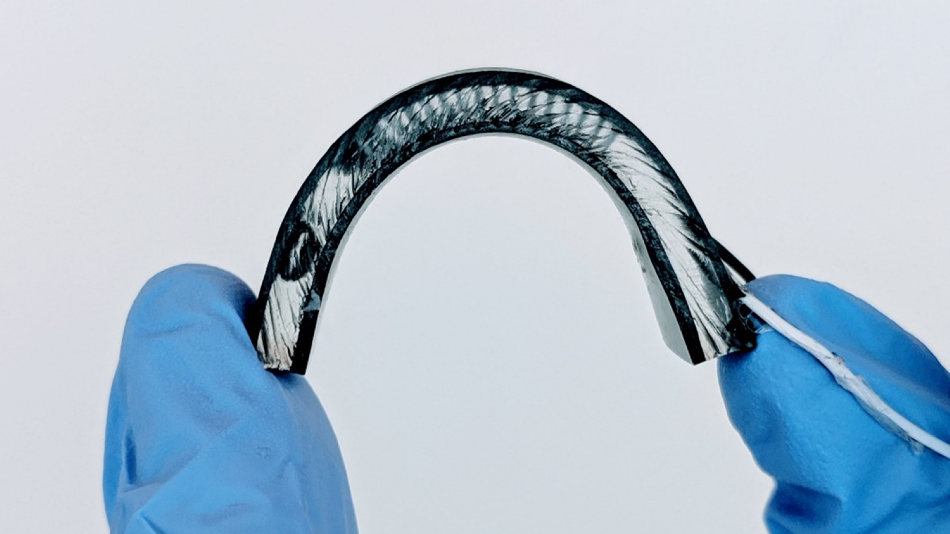Jan 31 2020
Engineers from North Carolina State University have developed a flexible device with the potential to tap heat energy from the human body and monitor health. The device outperforms all other flexible harvesters that make use of body heat as the only source of energy.
 NC State’s improved thermoelectric generator demonstrates efficiency and flexibility. Image Credit: Mehmet Ozturk, NC State University.
NC State’s improved thermoelectric generator demonstrates efficiency and flexibility. Image Credit: Mehmet Ozturk, NC State University.
In a study reported in Applied Energy, the researchers from NC State have described substantial improvements to the flexible body heat harvester they first developed in 2017. The harvesters power wearable technologies by tapping heat energy from the human body. The batteries of such wearable technologies—such as smartwatches that measure blood oxygen, heart rate, glucose, and other health parameters—never need to be recharged.
The technology is dependent on the same principles that govern rigid thermoelectric harvesters that transform heat into electrical energy.
Flexible harvesters that match with the human body are highly preferred for use with wearable technologies. According to Mehmet Ozturk, the corresponding author of the paper and a professor of electrical and computer engineering at NC State, excellent skin contact with flexible devices, together with the comfort and ergonomic considerations to the wearer of the device, are the main reasons for developing flexible thermoelectric generators (TEGs).
However, at present, flexible harvesters are far behind rigid devices in terms of efficiency and performance. This is because rigid devices have been outstanding in their potential to transform body heat into usable energy.
The flexible device reported in this paper is significantly better than other flexible devices reported to date and is approaching the efficiency of rigid devices, which is very encouraging.
Mehmet Ozturk, Professor of Electrical and Computer Engineering, North Carolina State University
In the proof-of-principle TEG, originally proposed in 2017, semiconductor elements were used, which were electrically connected in series with liquid-metal interconnects made of EGaIn. EGaIn is a non-toxic alloy of gallium and indium that offered both stretchability and metal-like electrical conductivity. The whole device was integrated into a stretchable silicone elastomer.
Although the architecture of the upgraded device is the same, it considerably enhances the thermal engineering of the earlier version. It also increases the density of the semiconductor elements that convert heat into electricity. One of the enhancements is an optimized silicone elastomer—typically a kind of rubber—that encloses the EGaIn interconnects.
The key here is using a high thermal conductivity silicone elastomer doped with graphene flakes and EGaIn.
Mehmet Ozturk, Professor of Electrical and Computer Engineering, North Carolina State University
The elastomer offers mechanical strength against punctures while optimizing the performance of the device.
Using this elastomer allowed us to boost the thermal conductivity—the rate of heat transfer—by six times, allowing improved lateral heat spreading.
Mehmet Ozturk, Professor of Electrical and Computer Engineering, North Carolina State University
Ozturk further stated that one of the capabilities of the technology is that it avoids the need for device manufacturers to create new flexible, thermoelectric materials since it includes the same semiconductor elements that are employed in rigid devices. He added that the focus of future studies will be to further enhance the efficiencies of these flexible devices.
The study was co-authored by Yasaman Sargolzaeiaval, Viswanath P. Ramesh, Taylor V. Neumann, Veena Misra, Michael Dickey, and Daryoosh Vashaee. The team has also recently obtained a patent on the technology.
The study was funded by NC State’s National Science Foundation-funded Advanced Self-Powered Systems of Integrated Sensors and Technologies (ASSIST) Center under grant EEC1160483. The aim of the ASSIST Center is to develop self-powered wearables with the potential for long-term multi-modal sensing without the need to charge or replace the batteries.
Source: https://www.ncsu.edu/